Features / Julia’s art installation sounds a warning about ‘human folly’ of overuse of plastics
FOR THE past month Shetland Museum has hosted a powerful installation piece by the artist Julia Barton that highlights the destructive effects of plastic on the environment, writes Paul Bloomer.
The floor of Da Gadderie has been turned into a giant ordnance survey map onto which imaginary islands, constructed from burnt plastics found at various locations around Shetland, are projected.
First impression is one of apocalypse and death: all life has been stripped from the islands because plastic has taken over. The imaginary archipelago is arranged not unlike Shetland and the names are derived from Shetland-inspired place names and locations crafted with the help of local people.
The plastic comes from various sources and the islands are named according to the source of the plastic. One group of islands is called Wrapper Skerries, Melted Holm, Bag Skerry and Sack Skerry, and all are constructed from burnt bags, wrappers and sacks highlighting the sick over-use of plastic packaging on everything that inevitably through various means finds it way into our oceans and on our beaches.
Capwick is formed by burnt bottle caps, island of rope and bay of nets, and fibre firth are formed by burnt discarded fishing nets and rope. We have Cord Island with Melting Point, Bay of Smoke and Reeky Holm.
We see Pipe Islands with Wipewick and Outflow Point made from burnt domestic plastics. There is the Island of Crate made from burnt fish boxes and Bottle Island made from burnt plastic bottles.
There is Wrapper Skerries made from the burnt black plastic that is used to bind silage its with offshoot islands The Melts. Shooting head is made from the plastic seal scarers from the aquaculture industry.
Julia started this project four years ago when after going on a mission to find seaweed to take prints from she became distraught at the sheer volume of plastic that crowded out everything else. To help pacify herself through the tears she started to gather some of the plastic that then lay for almost a year in her studio before starting to experiment with what to do with it.
Become a supporter of Shetland News
Lots of research on marine plastics ensued involving various agencies such as the Marine Conservation Society and a grant from creative Scotland enabled her to spend a year surveying the beaches of Wester Ross for the impact of plastics on the environment, all the time including the local schools in educational projects.
Many communities in an attempt to control the sheer volume of plastic on the beaches started to burn it leaving behind molten plastic deposits, which combines with the natural deposits of sand and earth to create over time its own geological layer. Plastic will be one of the main geological layers and markers of our time.
Julia continued this survey all over Shetland which is where the plastics for this exhibition was gathered. Whilst the focus of the show is on this giant floor map, Da Gadderie has another section where the visitor has chance to do their own research and reflection on the effects of plastic in the local environment.
An animation in collaboration with local filmmaker JJ Jamieson is centred around a small plastic commando figure that that was found on a beach who tells the story of how the plastic gets into the environment. Education is paramount to Julia and this animation reaches out to a young audience in an easy to understand and powerful way.
Julia has also been conducting workshops with local schools highlighting the problem of plastic pollution, raising awareness and encouraging research.
There is a series of cubes made from different plastics such as mussel pegs and cotton wool bud holders. She calls these carbon cubes and has calculated how much carbon and toxins are stored in each one that will leach into the environment on burning.
There are samples of sand collected from 60 beaches which are being analysed with a microscope during the various children’s workshops to work out how much micro plastic is present in the sand. The results of this will be displayed this Saturday.
This is an exhibition that every person in Shetland should make an effort to visit and reflect upon the dire warning Julia is highlighting. The islands are lifeless and devoid of life and unless we can collectively diminish our overuse of plastic our environment will continue to be polluted and diversity of life will diminish.
The work is a powerful prophetic warning and holds up a mirror to our human folly that we ignore at our peril. This is an ongoing project that will travel to other venues changing its form depending on what she finds in each place. The show finishes this weekend. Don’t miss it. You can read more at www.littoralartproject.com.
Paul Bloomer
Become a supporter of Shetland News
Shetland News is asking its many readers to consider start paying for their dose of the latest local news delivered straight to their PC, tablet or mobile phone.
Journalism comes at a price and because that price is not being paid in today’s rapidly changing media world, most publishers - national and local - struggle financially despite very healthy audience figures.
Most online publishers have started charging for access to their websites, others have chosen a different route. Shetland News currently has over 600 supporters who are all making small voluntary financial contributions. All funds go towards covering our cost and improving the service further.
Your contribution will ensure Shetland News can: -
- Bring you the headlines as they happen;
- Stay editorially independent;
- Give a voice to the community;
- Grow site traffic further;
- Research and publish more in-depth news, including more Shetland Lives features.
If you appreciate what we do and feel strongly about impartial local journalism, then please become a supporter of Shetland News by either making a single payment or monthly subscription.
Support us from as little as £3 per month – it only takes a minute to sign up. Thank you.








